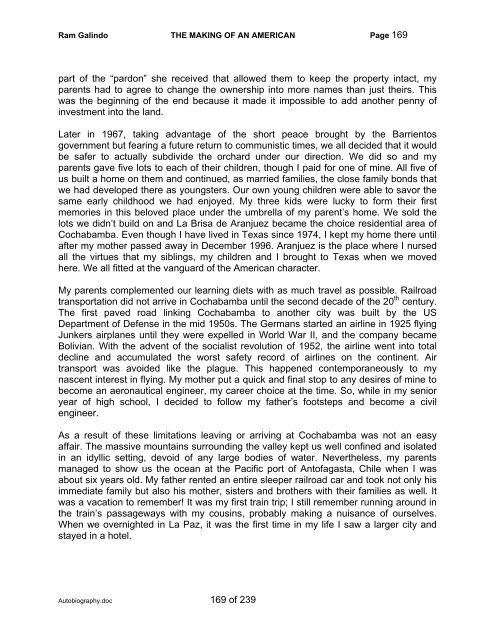Autobiography - The Galindo Group
Autobiography - The Galindo Group
Autobiography - The Galindo Group
Create successful ePaper yourself
Turn your PDF publications into a flip-book with our unique Google optimized e-Paper software.
Ram <strong>Galindo</strong> THE MAKING OF AN AMERICAN Page 169<br />
part of the “pardon” she received that allowed them to keep the property intact, my<br />
parents had to agree to change the ownership into more names than just theirs. This<br />
was the beginning of the end because it made it impossible to add another penny of<br />
investment into the land.<br />
Later in 1967, taking advantage of the short peace brought by the Barrientos<br />
government but fearing a future return to communistic times, we all decided that it would<br />
be safer to actually subdivide the orchard under our direction. We did so and my<br />
parents gave five lots to each of their children, though I paid for one of mine. All five of<br />
us built a home on them and continued, as married families, the close family bonds that<br />
we had developed there as youngsters. Our own young children were able to savor the<br />
same early childhood we had enjoyed. My three kids were lucky to form their first<br />
memories in this beloved place under the umbrella of my parent’s home. We sold the<br />
lots we didn’t build on and La Brisa de Aranjuez became the choice residential area of<br />
Cochabamba. Even though I have lived in Texas since 1974, I kept my home there until<br />
after my mother passed away in December 1996. Aranjuez is the place where I nursed<br />
all the virtues that my siblings, my children and I brought to Texas when we moved<br />
here. We all fitted at the vanguard of the American character.<br />
My parents complemented our learning diets with as much travel as possible. Railroad<br />
transportation did not arrive in Cochabamba until the second decade of the 20 th century.<br />
<strong>The</strong> first paved road linking Cochabamba to another city was built by the US<br />
Department of Defense in the mid 1950s. <strong>The</strong> Germans started an airline in 1925 flying<br />
Junkers airplanes until they were expelled in World War II, and the company became<br />
Bolivian. With the advent of the socialist revolution of 1952, the airline went into total<br />
decline and accumulated the worst safety record of airlines on the continent. Air<br />
transport was avoided like the plague. This happened contemporaneously to my<br />
nascent interest in flying. My mother put a quick and final stop to any desires of mine to<br />
become an aeronautical engineer, my career choice at the time. So, while in my senior<br />
year of high school, I decided to follow my father’s footsteps and become a civil<br />
engineer.<br />
As a result of these limitations leaving or arriving at Cochabamba was not an easy<br />
affair. <strong>The</strong> massive mountains surrounding the valley kept us well confined and isolated<br />
in an idyllic setting, devoid of any large bodies of water. Nevertheless, my parents<br />
managed to show us the ocean at the Pacific port of Antofagasta, Chile when I was<br />
about six years old. My father rented an entire sleeper railroad car and took not only his<br />
immediate family but also his mother, sisters and brothers with their families as well. It<br />
was a vacation to remember! It was my first train trip; I still remember running around in<br />
the train’s passageways with my cousins, probably making a nuisance of ourselves.<br />
When we overnighted in La Paz, it was the first time in my life I saw a larger city and<br />
stayed in a hotel.<br />
<strong>Autobiography</strong>.doc 169 of 239


